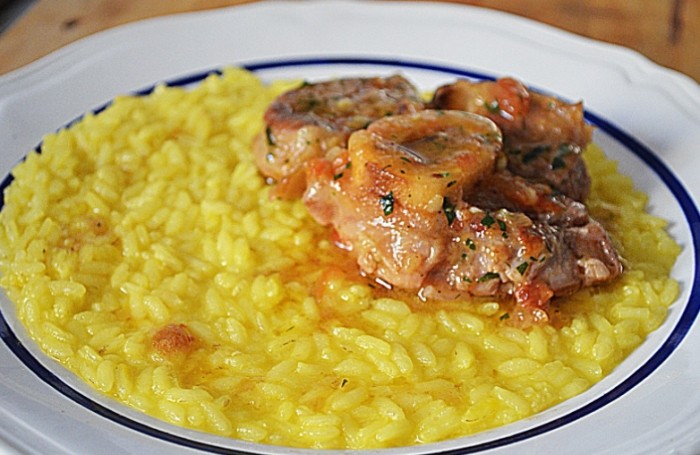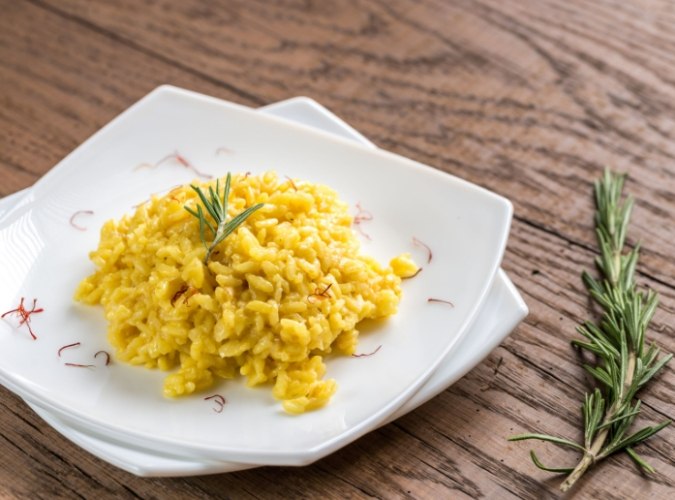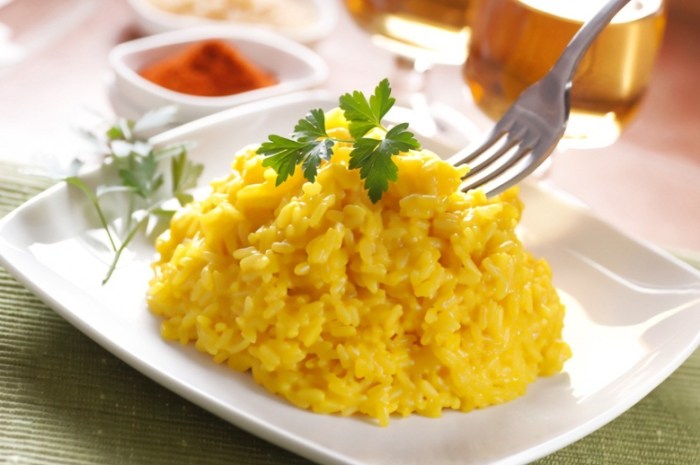Want to master Risotto Milanese ricetta? Discover the perfect blend of Risotto Milanese ingredients like saffron and bone marrow. Pair it with ossobuco for a classic combo! Learn how to make authentic Risotto Milanese ossobuco and Risotto Milanese bone marrow dishes now.
Table of Contents
- Historical Origins of Risotto Milanese
- Core Craftsmanship: The Art of Making Risotto Milanese
- Authentic Risotto Milanese Recipe
- Pairing Recommendations: Enhancing the Risotto Milanese Experience
- Regional Specialties: Risotto Milanese Around Italy
- Top Restaurants to Try Risotto Milanese in Milan
- Q&A: Answering Your Questions About Risotto Milanese
Risotto Milanese, a dish that exudes elegance and tradition, is a cornerstone of Italian culinary heritage. As a passionate traveler and food enthusiast, Ive had the privilege of exploring the diverse flavors of Italy, and Risotto Milanese stands out as a timeless classic that captures the essence of Milans culinary identity. In this comprehensive guide, Ill take you on a journey through the history, craftsmanship, and modern-day enjoyment of this iconic dish.
Historical Origins of Risotto Milanese

The Legend of the Golden Saffron
The story of Risotto Milanese begins in the 16th century, during the construction of Milans iconic Duomo. Legend has it that a young apprentice stained the rice with saffron, a precious spice brought to Italy by Arab traders, while working on the cathedrals stained glass windows. To avoid punishment, he added the golden-hued rice to a pot of stew, creating what would later become Risotto Milanese. This accidental masterpiece not only saved him from trouble but also introduced saffron as a defining ingredient in Milanese cuisine.
The Evolution of a Dish
Over the centuries, Risotto Milanese evolved from a humble workers meal to a dish synonymous with Milanese hospitality. It gained popularity among the citys aristocracy and eventually became a staple in Milanese households and restaurants. The dishs association with saffron, a symbol of wealth and luxury, further elevated its status, making it a must-try for visitors to Milan.
Core Craftsmanship: The Art of Making Risotto Milanese

The Essence of Arborio Rice
At the heart of Risotto Milanese lies Arborio rice, a short-grain variety renowned for its high starch content. This starch is crucial for achieving the dishs signature creamy texture. When cooked slowly with broth, the rice grains absorb the liquid while releasing their starch, creating a velvety consistency that defines authentic risotto.
The Role of Saffron
Saffron, the "golden spice," is what sets Risotto Milanese apart from other risotto variations. Harvested from the Crocus sativus flower, saffron threads are steeped in warm broth to release their vibrant color and earthy, floral flavor. This infusion not only imparts a beautiful golden hue to the risotto but also adds a depth of flavor that is both subtle and unforgettable.
The Technique: "Tostatura" and "Mantecatura"
-
Tostatura: The process begins with toasting the rice in butter or olive oil until it becomes translucent around the edges. This step, known as "tostatura," seals the grains and prepares them to absorb the broth evenly.
-
Mantecatura: As the rice cooks, hot broth is added in small increments, allowing the rice to absorb the liquid gradually. This method, called "mantecatura," is key to achieving the risottos creamy texture. The final touch involves stirring in a knob of butter and a generous handful of grated Parmesan cheese, creating a luxurious, velvety finish.
Authentic Risotto Milanese Recipe

Ingredients
- 2 cups Arborio rice
- 1 large onion, finely chopped
- 4 cups chicken or vegetable broth, heated
- 1/2 teaspoon saffron threads, steeped in 1/4 cup warm broth
- 1/2 cup dry white wine
- 1/2 cup unsalted butter, divided
- 1 cup freshly grated Parmesan cheese
- Salt and pepper to taste
Instructions
-
Prepare the Saffron Infusion: In a small bowl, steep the saffron threads in 1/4 cup of warm broth for 10 minutes.
-
Sauté the Onion: In a large, heavy-bottomed pan, melt 2 tablespoons of butter over medium heat. Add the chopped onion and sauté until translucent, about 5 minutes.
-
Toast the Rice: Add the Arborio rice to the pan and stir continuously for 2-3 minutes, until the grains are lightly toasted and coated in butter.
-
Deglaze with Wine: Pour in the white wine and stir until it is mostly absorbed by the rice.
-
Cook the Risotto: Begin adding the heated broth, one ladleful at a time, stirring constantly. Allow each addition to be absorbed before adding the next. Continue this process until the rice is tender but still slightly al dente, about 18-20 minutes.
-
Add Saffron Infusion: Once the rice is nearly cooked, stir in the saffron-infused broth, allowing the rice to absorb the golden liquid and develop its characteristic color.
-
Final Touches: Remove the pan from heat. Stir in the remaining butter and Parmesan cheese until fully incorporated. Season with salt and pepper to taste.
-
Serve: Let the risotto rest for a minute or two before serving. Garnish with additional Parmesan cheese and a sprinkle of saffron threads if desired.
Pairing Recommendations: Enhancing the Risotto Milanese Experience

Wine Pairings
- Barolo: This full-bodied red wine from Piedmont complements the richness of Risotto Milanese with its robust tannins and notes of dark fruit.
- Franciacorta Brut: For a lighter option, a crisp, sparkling Franciacorta Brut provides a refreshing contrast to the creamy risotto.
Main Course Pairings
- Osso Buco: This classic Milanese dish of braised veal shanks pairs beautifully with Risotto Milanese, creating a harmonious blend of flavors and textures.
- Grilled Chicken or Fish: For a lighter meal, grilled chicken or fish served alongside Risotto Milanese offers a balanced and satisfying dining experience.
Side Dishes
- Roasted Vegetables: A medley of roasted vegetables, such as zucchini, bell peppers, and cherry tomatoes, adds a fresh, vibrant element to the meal.
- Green Salad: A simple green salad dressed with a light vinaigrette provides a refreshing palate cleanser between bites of the rich risotto.
Regional Specialties: Risotto Milanese Around Italy
Milan: The Birthplace of a Classic
In Milan, Risotto Milanese is more than just a dish; its a symbol of the citys culinary heritage. Restaurants throughout the city serve variations of this classic, each with its own unique twist. From traditional trattorias to modern bistros, Risotto Milanese is a staple on menus across Milan.
Lombardy: A Region of Risotto Variations
Lombardy, the region surrounding Milan, is known for its diverse risotto dishes. While Risotto Milanese remains the most famous, other variations, such as Risotto alla Zucca (pumpkin risotto) and Risotto ai Funghi (mushroom risotto), showcase the regions bounty of seasonal ingredients.
Beyond Lombardy: Risottos National Appeal
Risotto has transcended regional boundaries to become a beloved dish throughout Italy. From the coastal regions of Liguria to the mountainous terrain of the Dolomites, risotto is adapted to incorporate local ingredients and flavors, creating a tapestry of regional specialties.
Top Restaurants to Try Risotto Milanese in Milan
1. Trattoria alla Campana
- Location: Centro Storico, Milan
- Specialty: Authentic Milanese cuisine served in a cozy, traditional setting. Their Risotto Milanese is made with locally sourced saffron and Arborio rice, resulting in a dish that is both creamy and aromatic.
- Price Range: Moderate
2. Ristorante Cracco
- Location: Via Victor Hugo, Milan
- Specialty: A Michelin-starred restaurant offering a modern twist on classic Italian dishes. Their Risotto Milanese is elevated with the addition of black truffle shavings, adding a luxurious touch to the traditional recipe.
- Price Range: High-end
3. Osteria del Binari
- Location: Navigli District, Milan
- Specialty: Known for its rustic charm and hearty portions, Osteria del Binari serves a classic Risotto Milanese that is both comforting and satisfying. The dish is often paired with a ion of local cheeses and cured meats.
- Price Range: Budget-friendly
4. Antica Trattoria della Pesa
- Location: Viale Pasubio, Milan
- Specialty: This historic trattoria has been serving Milanese specialties since 1880. Their Risotto Milanese is prepared using a generations-old recipe, ensuring an authentic taste of Milans culinary past.
- Price Range: Moderate
5. Ratanà
- Location: Isola District, Milan
- Specialty: A contemporary restaurant that blends traditional Italian flavors with modern culinary techniques. Their Risotto Milanese is a creative interpretation, featuring seasonal ingredients and a unique presentation.
- Price Range: High-end
Q&A: Answering Your Questions About Risotto Milanese
1. What is a Milanese risotto?
Milanese risotto, also known as Risotto Milanese, is a classic Italian dish originating from Milan. It is made with Arborio rice, saffron, butter, onion, white wine, and Parmesan cheese. The dish is characterized by its creamy texture and vibrant golden color, achieved through the infusion of saffron the broth used to cook the rice.
2. What does Milanese risotto taste like?
Risotto Milanese has a rich, creamy texture with a delicate balance of flavors. The saffron imparts a subtle earthy and floral note, while the Parmesan cheese adds a nutty, savory undertone. The dish is neither overly heavy nor overly light, making it a versatile choice for various occasions.
3. What do you eat with risotto alla Milanese?
Risotto alla Milanese pairs well with a variety of dishes. Classically, it is served alongside Osso Buco, a braised veal shank dish. However, it can also be enjoyed with grilled chicken, fish, or roasted vegetables. For a lighter meal, a green salad dressed with a light vinaigrette complements the creamy risotto nicely.
4. Why is risotto alla milanese famous?
Risotto alla Milanese is famous for several reasons. Firstly, its historical origins, dating back to the 16th century, add a layer of cultural significance to the dish. Secondly, the use of saffron, a precious and aromatic spice, elevates the risotto to a luxurious status. Finally, the dishs creamy texture and balanced flavors have made it a beloved classic in Italian cuisine, both in Italy and around the world.
Risotto Milanese is more than just a dish; its a journey through time, culture, and flavor. From its accidental origins to its status as a culinary icon, this golden-hued risotto continues to captivate food lovers worldwide. Whether enjoyed in a traditional Milanese trattoria or prepared at home, Risotto Milanese is a testament to the artistry and tradition of Italian cuisine. So, the next time you find yourself in Milan or craving a taste of Italy, be sure to savor a bowl of this timeless classic.
About the author:I’m Frank, the traveler and foodie behind Italy Travel Guide. For over a decade, I’ve been exploring every corner of Italy—from the canals of Venice to the lemon groves of the Amalfi Coast—sharing the best hidden gems, authentic trattorias, and charming boutique hotels along the way. My passion? Helping you experience Italy like a local, whether that means finding the perfect tiramisu in Florence, navigating Italy’s train system like a pro, or uncovering that tiny family-run vineyard in Tuscany. Join me as we dive la dolce vita, one unforgettable adventure at a time!
